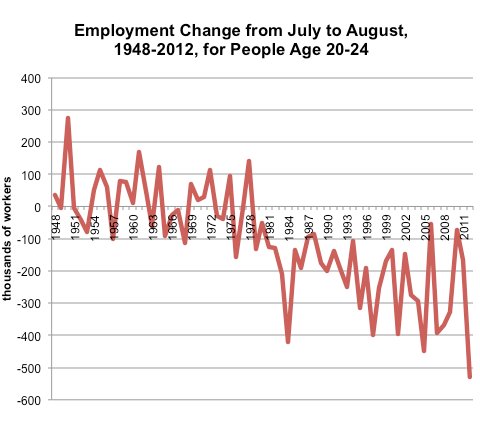7:32 p.m. | Updated

CATHERINE RAMPELL
Dollars to doughnuts.
The unemployment rate fell to 7.8 percent in September, its lowest level since President Obama took office. With just a month to go before the election, the news seemed too good to be true, at least for some Mitt Romney supporters.
Almost immediately some conservative pundits began accusing the Labor Department, which released the jobs numbers on Friday, of cooking the books. After all, the household survey — the survey that the unemployment rate comes from — showed that the number of people with jobs rose 873,000 in September, though the gain had averaged 164,000 each month earlier this year.
These numbers are always tremendously volatile, but the reasons are statistical, not political. The numbers come from a tiny survey with a margin of error of 400,000. Every month there are wild swings, and no one takes them at face value. The swings usually attract less attention, though, because the political stakes are usually lower.
 Look how noisy these numbers are, and always have been!
Look how noisy these numbers are, and always have been!
The numbers, by the way, are especially imprecise (and prone to revision) when the economy is making a turn, or when regular seasonal patterns start to change. And there is reason to believe that one particular seasonal pattern — the start of the college school year — may be partly responsible for the big swing in September.
One of the biggest sources of volatility in the last couple of months (and one of the major contributors to the big bump in job-getters in September) was the group of workers between 20 and 24 years old.
Historically, the employment levels for that group have dropped sharply in September, probably because many people in their early 20s are leaving summer jobs and going back to school.
For each year since 1948, the average level of employment for this group has fallen by 398,000 from August to September. In fact, before this year, employment for this age group had risen just two times in that period: 1954 (a gain of 5,000), and 1961 (a gain of 22,000).
This year was the third time on record that the number of people in this age group gained jobs in September, and the gain was big: 101,000.
 Source: Bureau of Labor Statistics. Numbers are not adjusted for seasonality.
Source: Bureau of Labor Statistics. Numbers are not adjusted for seasonality.
How to explain this major deviation from the historical trend, other than conspiracy theories?
If you look back at August, an unusually high share of this age group stopped working, compared with past employment patterns in August. From 1948 to 2011, the number of those 20 to 24 who had jobs fell by an average of 98,000 from July to August. This past August, it fell by 530,000, the biggest loss on record.
Over the last couple of decades, in fact, the job losses for this age group have been growing each August, suggesting that over time young people have been leaving their summer jobs earlier and earlier.
 Source: Bureau of Labor Statistics. Numbers are not adjusted for seasonality.
Source: Bureau of Labor Statistics. Numbers are not adjusted for seasonality.
In other words, seasonal patterns might be evolving — people starting school and leaving their summer jobs earlier in the summer — which has big implications for how the Labor Department digests and reports the monthly employment data.
The Bureau of Labor Statistics adjusts its raw survey data to correct for seasonal patterns, and since a decline in employment is expected for those 20 to 24, the economists at the bureau increased the level of employment for this group in the seasonally adjusted numbers.
Changes in seasonal patterns like this one can introduce more error into the headline numbers, and can at least partly explain why the overall change in household employment looked so much bigger in September than seems plausible. After seasonal adjustment, the increase in employment among those 20 to 24 was given as 368,000. That’s about 42 percent of the overall increase in employment growth for people of all ages. (After making seasonal adjustments on the August figures, the employment level for 20- to 24-year-olds was reported as declining by 250,000.)
All of which is to say the bureau aims to release the most informative numbers it can. But it is seeking to measure the state of the American job market quickly, based on surveys that are inherently incomplete — and the adjustments that are meant to fill in the gaps have their own shortcomings, particularly when seasonal trends change.
In case you still believe that the models the bureau uses are being manipulated to put President Obama in a better light, note that there are no political appointees currently serving in the Bureau of Labor Statistics. The employees are all career civil servants who have worked under both Republican and Democratic administrations. (The commissioner of the bureau is supposed to be a political appointee, but that position is vacant. The acting commissioner, John M. Galvin, has held the position since January, and he is a career civil servant.)
Economists at the Bureau of Labor Statistics regularly adjust the models they use to account for factors like seasonality and the number of new companies entering the economy, and the revisions are often very large.
Economists outside the bureau have been weighing in, too, both on how the latest numbers should be adjusted and what the next few months of jobs reports should look like. A paper presented last month as part of the Brookings Papers on Economic Activity series, for example, incorporated data on people flowing into and out of unemployment to forecast that the unemployment rate would most likely stagnate for a few months to come.
Article source: http://economix.blogs.nytimes.com/2012/10/05/explaining-the-big-gain-in-job-getters/?partner=rss&emc=rss